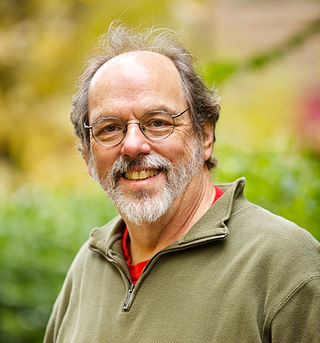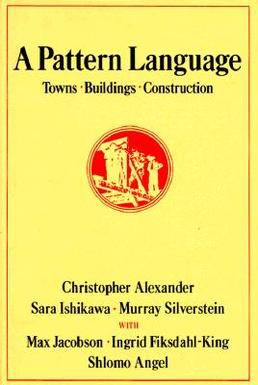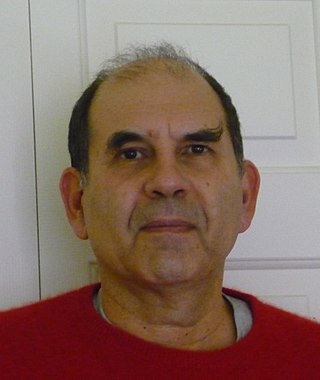Related Research Articles

Christopher Wolfgang John Alexander was an Austrian-born British-American architect and design theorist. He was an emeritus professor at the University of California, Berkeley. His theories about the nature of human-centered design have affected fields beyond architecture, including urban design, software, and sociology. Alexander designed and personally built over 100 buildings, both as an architect and a general contractor.

Howard G. Cunningham is an American computer programmer who developed the first wiki and was a co-author of the Manifesto for Agile Software Development. A pioneer in both design patterns and extreme programming, he started coding the WikiWikiWeb in 1994, and installed it on c2.com on March 25, 1995, as an add-on to the Portland Pattern Repository. He co-authored a book about wikis, entitled The Wiki Way, and invented the Framework for Integrated Test.
In software engineering, a software design pattern is a general, reusable solution to a commonly occurring problem within a given context in software design. It is not a finished design that can be transformed directly into source or machine code. Rather, it is a description or template for how to solve a problem that can be used in many different situations. Design patterns are formalized best practices that the programmer can use to solve common problems when designing an application or system.
A pattern language is an organized and coherent set of patterns, each of which describes a problem and the core of a solution that can be used in many ways within a specific field of expertise. The term was coined by architect Christopher Alexander and popularized by his 1977 book A Pattern Language.
The Portland Pattern Repository (PPR) is a repository for computer programming software design patterns. It was accompanied by a companion website, WikiWikiWeb, which was the world's first wiki. The repository has an emphasis on Extreme Programming, and it is hosted by Cunningham & Cunningham (C2) of Portland, Oregon. The PPR's motto is "People, Projects & Patterns".

A Pattern Language: Towns, Buildings, Construction is a 1977 book on architecture, urban design, and community livability. It was authored by Christopher Alexander, Sara Ishikawa and Murray Silverstein of the Center for Environmental Structure of Berkeley, California, with writing credits also to Max Jacobson, Ingrid Fiksdahl-King and Shlomo Angel. Decades after its publication, it is still one of the best-selling books on architecture.

Alireza Sagharchi RIBA FRSA is a British-Iranian architect. He is an internationally renowned and leading practitioner of contemporary classical architecture and traditional urban design. During his professional career, he has been responsible for major master planning and building projects in the UK, Europe, North America and the Middle East.
The International Network for Traditional Building, Architecture & Urbanism (INTBAU) is an international organization established in 2001. The organization arose from a research project initiated in 2000 at The Prince's Foundation for the Built Environment and undertaken by Dr Matthew Hardy, an architect and architectural historian. INTBAU is "dedicated to the support of traditional building, the maintenance of local character and the creation of better places to live", and has a Central Office located with three related charities in The Prince's Foundation for the Built Environment building in Shoreditch, London, United Kingdom.

Matthew Stadler is an American author who has written six novels and received several awards. Stadler has compiled four anthologies about literature, city life and public life. His essays, which have been published in magazines and museum catalogs, focus on architecture, urban planning and sprawl.

Nikos Angelos Salingaros is a mathematician and polymath known for his work on urban theory, architectural theory, complexity theory, and design philosophy. He has been a close collaborator of the architect Christopher Alexander, with whom Salingaros shares a harsh critical analysis of conventional modern architecture. Like Alexander, Salingaros has proposed an alternative theoretical approach to architecture and urbanism that is more adaptive to human needs and aspirations, and that combines rigorous scientific analysis with deep intuitive experience.

A Theory of Architecture is a book on architecture by Nikos Salingaros, published in 2006 by Umbau-Verlag, Solingen, Germany ISBN 3-937954-07-4. Cover recommendations are by Kenneth G. Masden II, Duncan G. Stroik, Michael Blowhard, and Dean A. Dykstra. Preface by Prince Charles, and Foreword by Kenneth G. Masden II. This book is a re-working of previously published articles used to teach a senior architecture studio class. Four of the twelve chapters were originally written in collaboration, and the co-authors include Michael Mehaffy, Terry Mikiten, Debora Tejada, and Hing-Sing Yu.

Orenco Station is a neighborhood of the city of Hillsboro, Oregon, United States. The planned urban town center was designed as a pedestrian-friendly, high-density community built in conjunction with TriMet’s Westside light rail. It was built on land formerly owned by the Oregon Nursery Company, land home around the turn of the 20th century to Orenco, a company town. During the Great Depression, the company went out of business, and much of the nursery land became vacant until re-development began in 1997. Orenco Station is near the intersection of NE Century Blvd. and Cornell Road, centered on the Orenco MAX Station.
Robert Bruegmann is an historian of architecture, landscape and the built environment. He is a professor at the University of Illinois at Chicago, and a specialist on the Chicago school of architecture. Bruegmann is best known for his research on the architectural firm of Holabird & Root, and is also a commentator on urban sprawl.

Alexander Tzonis is a Greek-born architect, author, and researcher. He has made contributions to architectural theory, history and design cognition, bringing together scientific and humanistic approaches in a synthesis. Since 1975, he has been collaborating in most projects with Liane Lefaivre. In 1985, he founded and directed Design Knowledge Systems (DKS), a multidisciplinary research institute for the study of architectural theory and the development of design thinking tools at TU Delft. Tzonis is known for his work on the classical canon, history of the emergence and development of modern architectural thinking, creative design by analogy, and introducing the idea of critical regionalism.

Wilhelmus "Winy" Maas is a Dutch architect, landscape architect, professor and urbanist. In 1993 together with Jacob van Rijs and Nathalie de Vries he set up MVRDV.
Intelligence-based design is the purposeful manipulation of the built-environment to effectively engage humans in an essential manner through complex organized information. Intelligence-Based Theory evidences the conterminous relationship between mind and matter, i.e. the direct neurological evaluations of surface, structure, pattern, texture and form. Intelligence-Based Theory maintains that our sense of well-being is established through neuro-engagement with the physical world at the deepest level common to all people i.e. "Innate Intelligence."

The Hillside Group is an educational nonprofit organization founded in August 1993 to help software developers analyze and document common development and design problems as software design patterns. The Hillside Group supports the patterns community through sponsorship of the Pattern Languages of Programs conferences.

The Timeless Way of Building is a 1979 book by Christopher Alexander that proposes a new theory of architecture that relies on the understanding and configuration of design patterns. Although it came out later, it is essentially the introduction to A Pattern Language and The Oregon Experiment, providing the philosophical background to the Center for Environmental Structure series.

New Classical architecture, New Classicism or Contemporary Classical architecture is a contemporary movement in architecture that continues the practice of Classical architecture. It is sometimes considered the modern continuation of Neoclassical architecture, even though other styles might be cited as well, such as Gothic, Baroque, Renaissance or even non-Western styles – often referenced and recreated from a postmodern perspective as opposed to being strict revival styles.

Miguel Robles-Durán is an urbanist, Associate Professor of Urbanism (tenured) at The New School / Parsons The New School for Design in New York City, and co-founder of the non-profit Cohabitation Strategies, a cooperative for socio-spatial research, design and development based in Rotterdam, Netherlands, and New York City, US.
References
- ↑ "Home". sustasis.org.
- ↑ Mehaffy, M. (2017). Cities Alive: Jane Jacobs, Christopher Alexander and the Roots of the New Urban Renaissance. Portland: Sustasis Press.
- ↑ "The UN's New Urban Agenda is Official...Now What?". 7 December 2016.
- ↑ Mehaffy, M and Salingaros, N. Design for a Living Planet. Portland: Sustasis Press.
- ↑ Mehaffy, M. W. (2015). Urban Form and Greenhouse Gas Emissions: Findings, Strategies, and Design Decision Support Technologies (Report).
- ↑ Roaf, S. and Bairstow, A. (Eds), The Oxford Conference: A Re-Evaluation of Education in Architecture. Southampton: WIT Press.
- ↑ Haas, T., New Urbanism and Beyond: Designing Cities for the Future. New York: Rizzoli.
- ↑ "Michael Mehaffy".
- ↑ Cunningham, Ward; Mehaffy, Michael W. (2013). "Wiki as pattern language". Proceedings of the 20th Conference on Pattern Languages of Programs, October 23–26, 2013, Monticello, Illinois. PLoP '13. Corryton, TN: The Hillside Group. pp. 32:1–32:14. ISBN 9781941652008.
- ↑ http://www.livingneighborhoods.org/library/generativecodesv10.pdf [ bare URL PDF ]
- ↑ "Lessons from an Emerging "Science of Cities"". 12 May 2014.
- ↑ "The Athens Dialogues".
- ↑ "Making TODs Work: Lessons from Portland's Orenco Station".
- ↑ "The Unbearable Cost of Sprawl". Bloomberg.com. 3 November 2011.
- ↑ http://www.livingneighborhoods.org/library/generativecodesv10.pdf [ bare URL PDF ]
- ↑ "Curriculum Vitae: Michael W Mehaffy" (PDF). Archived from the original (PDF) on 2016-11-19. Retrieved 2016-03-31.
- ↑ "Course details | Oxford University Department for Continuing Education". www.conted.ox.ac.uk. Archived from the original on 2010-12-30.
- ↑ "MSc in Sustainable Urban Development | The Prince's Foundation for Building Community". www.princes-foundation.org. Archived from the original on 2015-09-07.
- ↑ "Congress for the New Urbanism".
- ↑ "Center for Local Governance".
- ↑ "INTBAU College of Traditional Practitioners".
- ↑ "Home". January 2000.